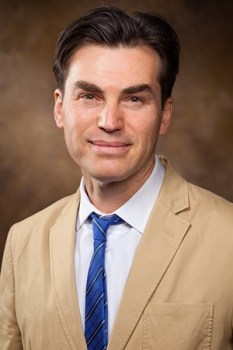May 30 2013
Physicists at the University of Arkansas have collaborated with scientists in the United States and Asia to discover that a crucial ingredient of high-temperature superconductivity could be found in an entirely different class of materials.
 Jak Chakhalian
Jak Chakhalian
“There have been more than 60,000 papers published on high-temperature superconductive material since its discovery in 1986,” said Jak Chakhalian, professor of physics at the University of Arkansas. “Unfortunately, as of today we have zero theoretical understanding of the mechanism behind this enigmatic phenomenon. In my mind, the high-temperature superconductivity is the most important unsolved mystery of condensed matter physics.”
Superconductivity is a phenomenon that occurs in certain materials when cooled to extremely low temperatures such as negative-435 degrees Fahrenheit. High-temperature superconductivity exists at negative-396 degrees Fahrenheit. In both cases electrical resistance drops to zero and complete expulsion of magnetic fields occurs.
Superconductors have the ability to transport large electrical currents and produce high magnetic fields, which means they hold great potential for electronic devices and power transmission.
The recent finding by the University of Arkansas-led team is important to further understand superconductivity, Chakhalian said.
An article detailing the finding, “Zhang-Rice physics and anomalous copper states in A-site ordered perovskites” was published Monday, May 13, in Scientific Reports, an online journal published by the journal Nature.
Derek Meyers, a doctoral student in physics at the U of A, found that the way electrons form in superconductive material — known as the Zhang-Rice singlet state — was present in a chemical compound that is very different from conventional superconductors.
“There is now a whole different class of materials where you can search for the enigmatic superconductivity,” Chakhalian said. “This is completely new because we know that the Zhang-Rice quantum state, which used to be the hallmark of this high-temperature superconductor, could be found in totally different crystal structures. Does it have a potential to become a novel superconductor? We don’t know but it has all the right ingredients.”
Meyers was the lead researcher. Srimanta Middey, a postdoctoral research associate at the university and Benjamin A. Gray, a doctoral student, performed the theoretical calculations and analyzed the experimental data obtained at the X-ray synchrotron at Argonne National Laboratory near Chicago.
In the mid-1980s, physicists determined that all high-temperature superconductive material must contain copper and oxygen and those elements arrange two-dimensionally.
In this material the electrons combine into a unique quantum state called the Zhang-Rice singlets, Chakhalian explained.
“I can make a closed circuit out of the superconducting material, cool it down and attach a battery that starts the flow of the electrons. The current goes around the loop. Then I detach it and leave it. Hypothetically, 1 billion years later the flow of electrons is guaranteed to be exactly the same — with no losses,” he said. “But the problem is we don’t know if we are even using it right. We have no microscopic understanding of what is behind it.”
For this project, Chakhalian acquired complex oxides from the University of Texas in Austin, in close collaboration with chemists John Goodenough and J.G. Cheng. Chakhalian’s group, led by Meyers, conducted experiments on them at the Advanced Photon Source at Argonne National Laboratory.
Meyers, from Rogers, Ark., is attending the U of A on a Doctoral Academy Fellowship, which provides him an annual stipend of $10,000 to apply to his graduate research.
Chackhalian holds the Charles and Clydene Scharlau Chair in the J. William Fulbright College of Arts and Sciences.
The research team also included theorists Swarnakamal Mukherjee and Tanusri Saha Dasgupta of the S. N. Bose National Centre for Basic Sciences in Calcutta, India; Goodenough and Cheng of the University of Texas (Cheng also with the University of Tokyo and Chinese Academy of Sciences) and John W. Freeland of the Advanced Photon Source at Argonne National Laboratory.